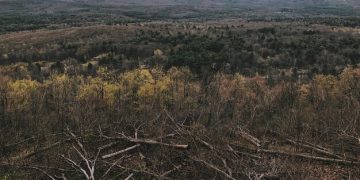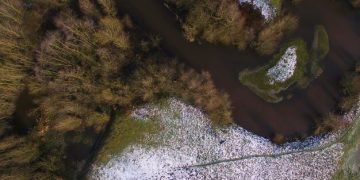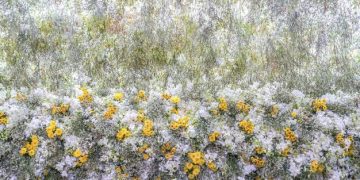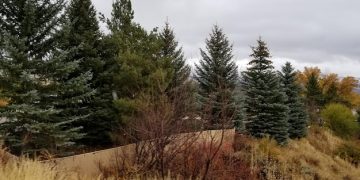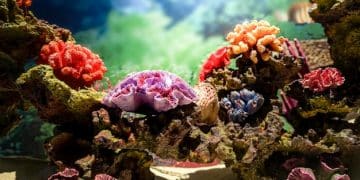Drought’s Impact: How US Wildlife and Ecosystems Suffer
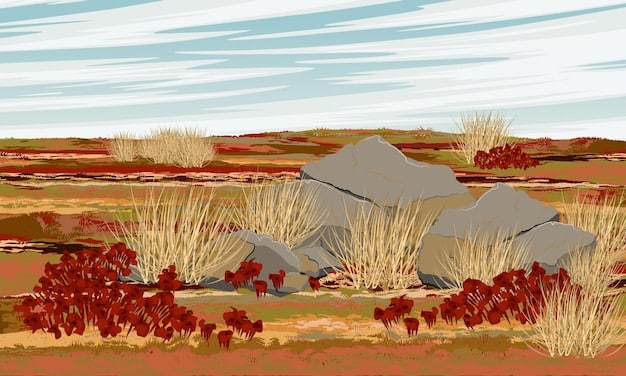
The current drought in the US significantly impacts wildlife and ecosystems by reducing water availability, increasing stress on species, altering habitats, and exacerbating wildfire risks, leading to biodiversity loss and ecosystem instability.
The relentless grip of drought across the United States is more than just parched landscapes and water restrictions. It’s a silent crisis unfolding for the nation’s wildlife and ecosystems. How Does the Current Drought Affect Wildlife and Ecosystems Across the US? The answers are complex and devastating, with repercussions that could reshape the natural world for years to come.
Understanding the Severity of the US Drought
Drought isn’t just a lack of rain; it’s a prolonged period of abnormally low rainfall, leading to a scarcity of water resources. Understanding the current drought situation requires examining its scale, duration, and intensity across different regions of the United States. The consequences ripple through entire ecosystems, affecting everything from microscopic organisms to apex predators.
Drought Severity Metrics
Scientists use various metrics to measure drought severity, including the Palmer Drought Severity Index (PDSI) and the US Drought Monitor. These tools consider factors like precipitation, temperature, soil moisture, and streamflow to assess the extent and intensity of drought conditions.
Areas Most Affected
While drought can impact any region, certain areas in the US are particularly vulnerable. The Southwest, Great Plains, and California have experienced prolonged and severe droughts, leading to significant ecological damage. These regions rely heavily on surface water and groundwater resources that are quickly depleted during extended dry periods. Reduced snowpack in mountainous regions also exacerbates water scarcity during the warmer months, impacting ecosystems downstream.
- Water Scarcity: Depleted water sources force animals to compete for limited resources.
- Habitat Loss: Drying wetlands and forests reduce suitable habitats for many species.
- Increased Wildfire Risk: Dry vegetation fuels more frequent and intense wildfires.
The current drought afflicting the United States is a substantial environmental calamity. Its repercussions, originating from metrics assessing drought severity, are especially pronounced in susceptible zones like the Southwest, Great Plains, and California. These impacts are intricately connected, leading to cascading effects that compromise the well-being of both wildlife and ecosystems.
Impact on Water Resources and Aquatic Life
One of the most immediate and visible impacts of drought is the depletion of water resources. Rivers, lakes, and wetlands shrink or dry up completely, devastating aquatic ecosystems and the wildlife that depend on them. Fish populations, amphibians, and waterfowl are particularly vulnerable to these effects.
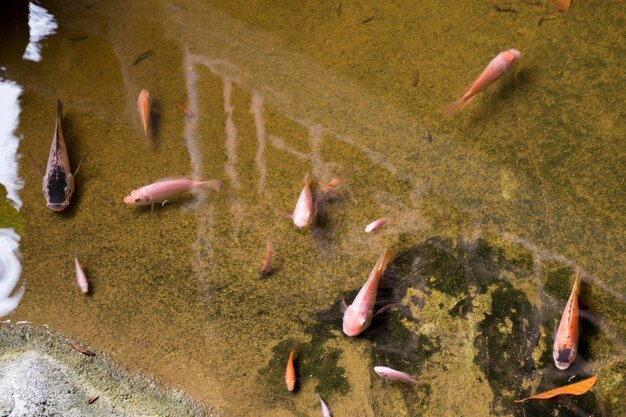
Effects on Fish Populations
Reduced streamflow and increased water temperatures can lead to fish kills, especially in sensitive species like salmon and trout. Lower oxygen levels in the water also stress fish, making them more susceptible to disease. Fragmented habitats prevent fish from migrating to spawn or find suitable refuge. Competition increases as populations are crowded into smaller areas, leading to starvation and reduced reproductive success.
Impacts on Wetlands and Waterfowl
Wetlands serve as crucial breeding and feeding grounds for many waterfowl species. During drought, these wetlands shrink or dry up, reducing the extent of suitable habitat for birds. This can lead to declines in waterfowl populations and affect migration patterns. Shorebirds that rely on shallow wetlands for foraging also suffer when water levels drop. The overall health and diversity of these ecosystems diminishes.
The scarcity of water during drought conditions has dire consequences for aquatic life, affecting fish and waterfowl populations alike. The loss of access to sufficient water resources disrupts food chains, impairs reproductive cycles, and escalates competition among inhabiting species, precipitating a decline in ecological balance.
Terrestrial Wildlife and Habitat Degradation
Drought impacts aren’t limited to aquatic ecosystems. Terrestrial wildlife also faces significant challenges as habitats degrade and food resources become scarce. Many animals rely on specific vegetation types for food and shelter, and drought can alter plant communities, impacting their survival.
Changes in Vegetation Composition
Prolonged drought can lead to changes in vegetation composition as drought-tolerant species replace those that require more moisture. This can alter the structure and function of ecosystems, affecting the animals that depend on specific plant types. For example, the loss of forests can reduce habitat for birds and mammals that rely on tree cover for nesting and protection.
Increased Competition for Resources
As food and water become scarce, terrestrial wildlife faces increased competition for resources. This can lead to stress, malnutrition, and increased mortality rates, especially among young animals. Animals may also expand their ranges in search of food and water, leading to conflicts with humans and other wildlife populations. The degradation and contraction of obtainable resources create an increasingly competitive landscape for wildlife.
- Habitat Fragmentation: Limited water sources isolate populations, reducing genetic diversity.
- Food Scarcity: Reduced plant growth impacts herbivores and the predators that feed on them.
- Disease Outbreaks: Stressed animals are more vulnerable to disease.
Drought profoundly impacts terrestrial wildlife, altering fundamental aspects of their habitats and food sources. Such environmental alterations introduce complexities into the struggle for survival, influencing species interaction, altering ecosystems, and potentially precipitating long-term ecological transformations.
The Role of Wildfires in Drought-Stricken Areas
Drought significantly increases the risk of wildfires, which can have devastating consequences for wildlife and ecosystems. Dry vegetation serves as fuel, and strong winds can quickly spread fires across large areas. Wildfires can destroy habitats, kill animals, and release large amounts of carbon dioxide into the atmosphere, further exacerbating climate change.
Increased Frequency and Intensity of Wildfires
Drought creates ideal conditions for wildfires to ignite and spread rapidly. The combination of dry vegetation, low humidity, and high temperatures makes forests and grasslands highly susceptible to fire. Climate change is also playing a role, with warmer temperatures and longer dry seasons contributing to more frequent and intense wildfires. The resulting destruction is an environmental catastrophe.
Impacts on Wildlife and Habitat Recovery
Wildfires can have immediate and long-term impacts on wildlife. Animals may be killed or injured in the fires, and their habitats can be destroyed. Post-fire landscapes can be slow to recover, as soil erosion, invasive species, and altered vegetation patterns hinder the return of native ecosystems. The alteration of habitats may displace wildlife, impacting biodiversity.
The amplified frequency and intensity of wildfires, a direct consequence of drought conditions, present immense risks to the wellness of both wildlife and ecosystems. From the immediate threat to habitats and organisms to the broader consequences for biodiversity and climate, wildfires represent a destructive manifestation of drought’s larger impact.
Ecosystem Alterations and Long-Term Consequences
The impacts of drought extend beyond immediate effects on wildlife and water resources. Prolonged drought can lead to long-term changes in ecosystem structure and function, affecting biodiversity, carbon sequestration, and other vital ecological processes. The recovery process of ecosystems is slow and can be unpredictable after prolonged periods of low precipitation.
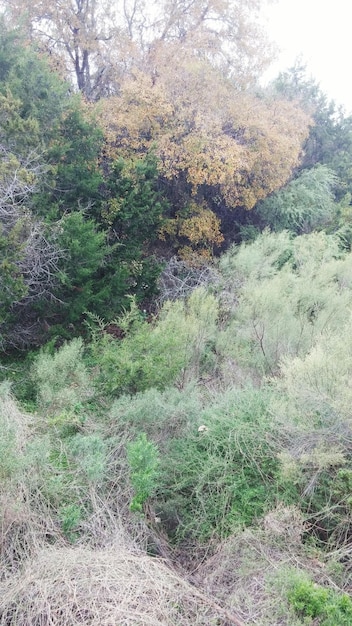
Shifts in Species Distribution
As habitats change, species may shift their distributions in search of more suitable conditions. This can lead to range expansions for some species and contractions for others. Invasive species may also thrive in drought-stressed ecosystems, outcompeting native plants and animals. Changes in species ranges can alter ecosystem dynamics.
Impacts on Soil Health and Nutrient Cycling
Drought can negatively impact soil health by reducing soil moisture, increasing erosion, and altering nutrient cycling. Dry soils are more susceptible to wind and water erosion, leading to the loss of topsoil and nutrients. Reduced plant growth also limits the amount of organic matter that returns to the soil, further depleting soil fertility. A reduction in soil nutrients can reduce plant growth and vigor.
The environmental effects of protracted drought transcend immediate impacts, producing enduring modifications in the structure and function of ecosystems. These alterations potentially impact biodiversity, carbon sequestration, and the inherent ability of environments to support a diverse array of life, emphasizing the profound consequences of sustained dry conditions.
Mitigation and Conservation Strategies
Addressing the impacts of drought requires a multifaceted approach that includes mitigation, conservation, and adaptive management strategies. Reducing greenhouse gas emissions, improving water management practices, and restoring degraded habitats are all essential steps in building resilience to drought.
Water Conservation Measures
Implementing water conservation measures in agriculture, industry, and urban areas can help reduce demand on water resources and extend the availability of water during drought. Improving irrigation efficiency, reducing water waste, and promoting water-wise landscaping are all important steps. Effective water management can reduce stress on ecosystems during drought.
Habitat Restoration and Management
Restoring degraded habitats can improve their ability to withstand drought and provide refuge for wildlife. This can include restoring wetlands, planting native vegetation, and removing invasive species. Managing ecosystems to promote resilience to drought is crucial for long-term conservation. Protecting and restoring ecosystems benefits both wildlife and humans.
- Sustainable Agriculture: Implementing practices that reduce water consumption and soil erosion.
- Climate Change Mitigation: Reducing greenhouse gas emissions to slow the pace of climate change.
- Community Engagement: Educating the public about the importance of water conservation and ecosystem protection.
Mitigation and conservation strategies are indispensable in addressing the far-reaching impacts of drought on ecosystems and wildlife. Through the incorporation of practices enhancing water management, habitat rehabilitation, and holistic environmental responsibility, we can enhance ecological resilience and safeguard natural environments from the protracted consequences of dry spells.
| Key Point | Brief Description |
|---|---|
| 💧 Water Scarcity | Reduced water impacts aquatic life and increases competition. |
| 🔥 Wildfires | Drought increases wildfire risk, destroying habitats. |
| 🌿 Habitat Loss | Drought-tolerant species replace native plants, changing habitats. |
| 🌍 Ecosystem Shifts | Species distributions change, affecting ecological processes. |
Frequently Asked Questions
▼
The main causes include natural climate variability, such as El Niño and La Niña, and human-induced climate change, leading to increased temperatures and altered precipitation patterns. Deforestation and changes in land use can also exacerbate drought conditions.
▼
Drought can lead to reduced crop yields, increased irrigation costs, and livestock losses. Farmers may be forced to implement water conservation measures, switch to more drought-resistant crops, or reduce the amount of land under cultivation.
▼
Individuals can conserve water by using water-efficient appliances, reducing lawn watering, and fixing leaks. They can also support policies that promote water conservation and reduce greenhouse gas emissions. Reducing meat consumption can also lessen the impact on water demand.
▼
Drought can reduce the availability of water for urban areas, leading to water restrictions, increased water rates, and potential shortages. Cities may need to invest in alternative water sources, such as desalination or water recycling, to ensure a reliable water supply.
▼
Long-term solutions include investing in water infrastructure, implementing sustainable water management practices, promoting drought-resistant agriculture, and addressing climate change through reduced emissions and increased carbon sequestration. Comprehensive planning is essential.
Conclusion
The ongoing drought in the United States poses a significant threat to wildlife and ecosystems, with far-reaching consequences for biodiversity, water resources, and overall ecological health. By understanding the causes and impacts of drought, and implementing effective mitigation and conservation strategies, we can help build resilience to drought and protect the natural world for future generations.
